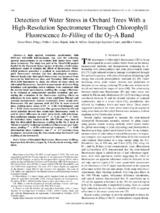Mostrar el registro sencillo del ítem
Detection of water stress in orchard trees with a high-resolution spectrometer through Chlorophyll fluorescence in-filling of the O-2-A band
| dc.contributor.author | Miller, John R. | es_ES |
| dc.contributor.author | Pérez-Priego, Óscar | es_ES |
| dc.contributor.author | Zarco-Tejada, Pablo J. | es_ES |
| dc.contributor.author | Fereres Castiel, Elías | es_ES |
| dc.contributor.author | Sepulcre-Cantó, Guadalupe | es_ES |
| dc.date.accessioned | 2010-12-29T09:51:40Z | |
| dc.date.available | 2010-12-29T09:51:40Z | |
| dc.date.issued | 2005 | |
| dc.identifier.issn | 0196-2892 | |
| dc.identifier.uri | http://hdl.handle.net/10396/3961 | |
| dc.description.abstract | A high spectral resolution spectrometer with 0.065-nm full-width half-maximum was used for collecting spectral measurements in an orchard field under three water stress treatments. The study was part of the FluorMOD project funded by the European Space Agency to develop a leaf-canopy reflectance model to simulate the effects of fluorescence. Water deficit protocols generated a gradient in solar-induced Chlorophyll fluorescence emission and tree physiological measures. Diurnal steady-state Chlorophyll fluorescence was measured from leaves in the field between June and November 2004 using the PAM-2100 fluorometer to study the effects of water stress on Chlorophyll fluorescence. Spectral measurements of downwelling irradiance and upwelling crown radiance were conducted with the narrow-band spectrometer, enabling the canopy reflectance to be obtained at sulmanometer spectral resolution and permitting the evaluation of the fluorescence in-filling effects on reflectance in trees under water stress conditions. Diurnal and seasonal measurements showed consistently lower steady-state fluorescence (Ft) and quantum yield Delta F/Fm' in water-stressed trees, yielding mean values of Ft = 0.38 (well-irrigated) and Ft = 0.21 (water-stressed trees). The agreement between Ft and water potential showed that steady-state fluorescence could be used to detect differences in water stress levels, with determination coefficients ranging between r(2) = 0.48 and r(2) = 0.81 for individual dates. Analysis in the 680-770-nm range showed that the Chlorophyll fluorescence in-filling in the O-2-A band at 760 urn is sensitive to diurnal variations of fluorescence and water stress, yielding r(2) = 0.76 (well-watered treatment), r(2) = 0.89 (intermediate stress treatment), and T 2 = 0.7 (extreme stress treatment), demonstrating the close relationships between Ft and in-filling at the crown level. | en |
| dc.format.mimetype | application/pdf | es_ES |
| dc.language.iso | eng | es_ES |
| dc.publisher | IEEE | es_ES |
| dc.rights | https://creativecommons.org/licenses/by-nc-nd/4.0/ | es_ES |
| dc.source | Ieee Transactions on Geoscience and Remote Sensing 43 (12), 2860-2869 (2005) | es_ES |
| dc.subject | Olive tree | en |
| dc.subject | Water stress | en |
| dc.subject | Electron-Transport | en |
| dc.subject | Chlorophyll fluorescence | en |
| dc.subject | Fluorescence in-filling | en |
| dc.subject | Vegetation apparent reflectance | en |
| dc.subject | Oxygen O-2-A band | en |
| dc.title | Detection of water stress in orchard trees with a high-resolution spectrometer through Chlorophyll fluorescence in-filling of the O-2-A band | es_ES |
| dc.type | info:eu-repo/semantics/article | es_ES |
| dc.rights.accessRights | info:eu-repo/semantics/openAccess | es_ES |

